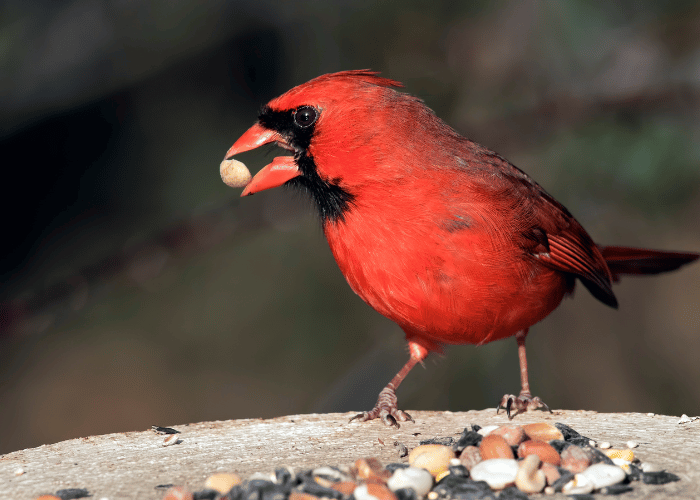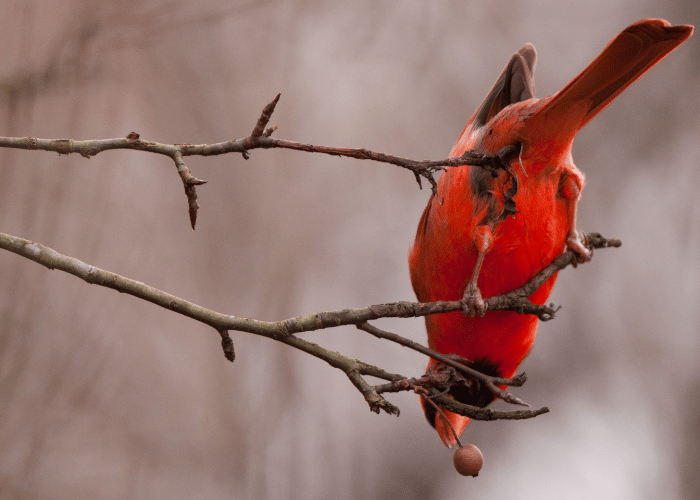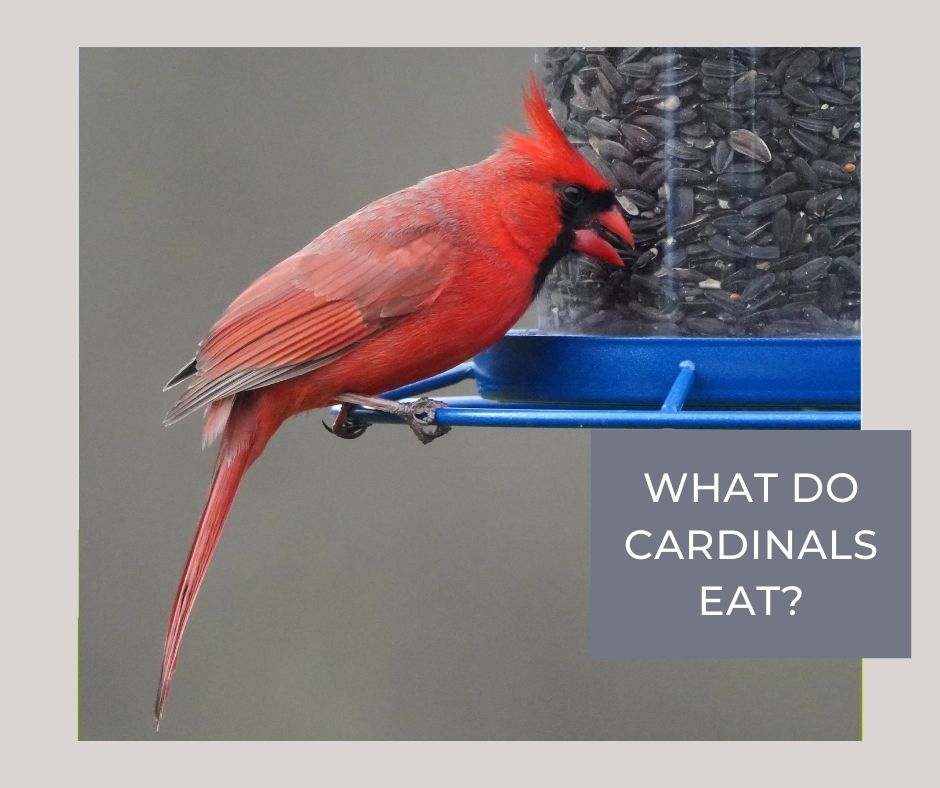What Do Cardinals Eat
Table of Contents
So, you’re curious about what cardinals eat? Well, let me assure you, these beautiful and vibrant birds have quite an intriguing diet. Cardinals need to take in a variety of food items to keep fueling their energetic lifestyle.
Your garden might be a dining hall for the Northern Cardinal and they would simply love it if you had some sunflower seeds laying around. Considered their favorite, these birds just can’t resist the lure of these tiny treats. They’ll also chow down on other seeds, fruit and insects, if available.
In winter though, it’s a game changer. Surprisingly, they switch to a diet mainly composed of berries and small fruits. Amazing right? Now you’re reading the cardinal diet like a pro! It’s important to note that they really relish the berries of dogwood, wild grape and sumac. So, while these chirpy friends can adapt their diet to what’s available, having a garden rich in variety could make your yard a cardinal’s paradise!

Unveiling the Diet: What Cardinals Generally Eat
Have you ever caught sight of that flash of red in your backyard and wondered what that striking bird – the cardinal – is munching on? Cardinals are actually omnivores. Their diet mainly includes seeds, grains, fruits, and insects. So, when you see them in your garden, they’re probably looking for a tasty meal!
You’ll find that seeds are a significant part of their diet. In fact, about 90% of a cardinal’s diet in winter is seeds and grains. When you’re setting up a bird feeder for cardinals, sunflower seeds, safflower seeds, and millet are some of their favorite picks.
They also have quite the sweet beak, you know! Fruits and berries make up a good portion of their diet too. Cardinals love snacking on wild grapes, mulberries, blackberries, and raspberries.
| Season | Major Diet Components |
|---|---|
| Winter | Seeds, grains |
| Spring, Summer, Fall | Seeds, grains, fruit, insects |
Guess what? These bright colored birds are also known to eat a wide variety of insects – beetles, grasshoppers, caterpillars, and more during spring, summer, and fall.
You’d think that’s enough variety, but there’s more! When available, cardinals aren’t beyond nibbling on maple sap and drinking from nectar-rich flowers. It’s quite the menu, isn’t it?
However, do remember that this doesn’t mean all food is good for them. While they may occasionally eat mealworms, large quantities can lead to calcium deficiency. Also, bread and similar foods lack the nutrients cardinals need, so it’s best to stick to foods that are natural to their diet.
So, if you’re hoping to attract these beauties to your backyard, now you have an idea of what to set out for them. But guess what? The cardinal’s diet varies with its geographic location, so the menu can get even wider! That’s a topic for another section though. For now, just know that they have quite the varied palette!
Captivating Cardinals: The Seeds and Berries They Love
When you spot a cardinal in your backyard, ever wonder what’s on their menu? Well, believe it or not, these brightly colored beauties have quite the diverse diet, ranging from seeds to fruits, berries, and more.
Sunflower seeds rank high on any cardinal’s list. It’s their favorite snack! They’re crazy about the high content of fat and protein that makes them rather irresistible. Hence, if you’re planning to attract these lovely guests to your backyard, sprinkling some sunflower seeds around would do the trick.
But that’s not all they eat. If you examine a cardinal’s delicate beak, you’ll notice it’s perfectly designed to crack open seeds and nuts. Do you know what that means? They love eating a mixed bag of seeds which includes safflower seeds, corn, and more. Suffice to say, seeds make up the bulk of a cardinal’s overall diet.
Onto something sweeter, cardinals also have a taste for berries. Oh yes, their diet is not just limited to seeds. From mulberries to elderberries, dogwood berries to wild grapes, you’ll often spot a cardinal indulging in these juicy fruits.
Let’s lay out the cardinal’s favorite snacks:
- Sunflower seeds
- Mixed seeds (safflower seeds, corn, etc.)
- Berries (mulberries, elderberries, etc.)
Insects and spiders also make it onto the cardinal’s plate. Surprised? Well, they need some protein in their diet and a fat juicy insect can be quite the treat! But don’t worry, their primary food sources remain plant-based.
Understanding what cardinals eat will help you better appreciate these birds, especially if you’re a birdwatching enthusiast or if you’ve got a bird feeder at home. So next time you spot a cardinal singing on your tree, remember, it’s probably eyeing your sunflower seeds or the ripe berries nearby.
Take note, your backyard could become the desired dining destination for these enchanting creatures if you just add a touch of their favorite food. Enjoy the magic of cardinals in your backyard!

Cardinals In Winter: How They Survive on Their Diet
Winter can be a tough time for many of our feathered friends, but cardinals have a unique approach to facing cold weather. Unlike many birds, cardinals don’t fly south for the winter. That’s right – these resilient birds stay put all year round, even when the snow starts to fall. So how do they manage it? Well, it’s all about their diet.
Cardinals are omnivores, meaning they eat a mix of seeds, grains, fruits, insects and occasionally small animals. In the warmer months, you’ll often see them munching on beetles, grasshoppers, and spiders. But come winter, their food sources change drastically. Most insects are hard to come by, and vegetation can be buried under snow. So, the cardinals adapt.
It’s amazing how well these birds know their environment. They focus on the leftover berries, seeds, and grains that they can find around, making the most of the scarce food available. And if they’re really lucky, they find well-stocked bird feeders, where they often feast on sunflower seeds. Now that’s some smart winter foraging!
One particularly fascinating part of their wintry diet is the bitter tasting fruits and berries. You see, many birds and animals can’t stomach these, but cardinals, they don’t mind them one bit. And there’s a bonus: the high sugar content in these fruits provides the extra energy they need to stay warm. It’s truly quite resourceful!
Here’s a mini snapshot of the cardinal winter diet:
| Food Source | Common Types |
|---|---|
| Seeds | Sunflower, safflower, corn, millet |
| Fruits | Hackberries, wild grapes, sumac |
| Berries | Dogwood, blackberry, mulberry |
So, by shifting their diet and making good use of what’s available to them, cardinals manage to survive, and thrive, even in the harshest winter conditions. Now, that’s worth admiring, don’t you think? If there’s one thing we can learn from these exceptional birds, it’s the power of adaptability. So, next time you see a cardinal in winter, you’ll know just how well it’s managing to hang on through those chilly days.
The Allure of Insects: Unexpected Items in a Cardinal’s Menu
You might think our feathered friends, the cardinals, only munch on seeds and berries. But in reality, there’s far more to their diet than you’d initially expect. An insect or two might even make its way into a hungry cardinal’s meal!
In the warmer months, especially during breeding and nesting season, insects make up a significant portion of a cardinal’s diet. You see, insects are rich in protein, a nutrient that’s crucial for the growth and development of young birds. To give you a clear picture, here’s a breakdown:
| Food Type | Percentage of Diet |
|---|---|
| Insects | 35% |
| Seeds/Berries | 65% |
The insects most commonly found in a cardinal’s diet include:
- Beetles
- Grasshoppers
- Spiders
- Caterpillars
- Snails
But don’t let the above list fool you. Our cardinal friends aren’t exactly picky eaters when it comes to insects. They’ll happily consume whatever is readily available in their environment.
Now, you’re probably wondering, how do these birds find and catch their buggy treats? Well, it’s actually a remarkable process. Cardinals typically search for insects on or near the ground, using their keen eyesight and sharp beaks to snatch up their prey.
If you’re a bird watcher or just someone who wants to attract more cardinals to your yard, keep in mind what we’ve learned here. Offering a mix of seeds, berries, and even live mealworms (a favorite insect snack!) in your bird feeder, will surely make your yard more appealing to these wonderfully vibrant birds.
Take note, cardinals play an important role in controlling insect populations, too. So, if you notice fewer pesky bugs around your property—you might just have a diligent cardinal to thank.
The variety and adaptability in a cardinal’s diet remind us of nature’s remarkable resilience. From seeds to insects, they cost effectively manage their meals while satisfying their nutritional needs. So next time you spot a cardinal, you’ll know there’s more than meets the eye when it comes to these intriguing creatures’ menu.

Backyard Delights: How to Attract Cardinals with Food
So you’re intrigued by cardinals and you’d love to have these stunning birds frequent your backyard, right? Cardinals love to eat, and creating a cardinal-friendly menu is the way to their little birdie hearts!
Primarily, cardinals are sophisticated diners and love a variety of foods. For starters, seeds should always be on the top of your shopping list. Sunflower seeds and safflower seeds are particularly enticing. They’re packed with protein and make a nutritious meal for our feathered friends. Cardinals aren’t picky about the form either – whole, hulled, or even crushed seeds do the trick!
Remember those seeds we mentioned? Make sure you’re setting them out the right way. Cardinals aren’t too keen on swaying while they eat, so they prefer platform or tray feeders where they can perch and eat in peace.
Now, let’s talk fruits. Cardinals absolutely delight in small fruits and berries. Favorites include:
- Apples
- Grapes
- Mulberries
- Raspberries
Hint: You could place these on your tray feeder or scatter them around your yard, they’ll love the treat!
Insects aren’t left out of their diet either. Caterpillars and beetles add a much-needed variety to a cardinal’s diet. If you’re not a fan of dealing with live insects, you’re in luck! Cardinals also munch on mealworms, a fantastic—and less squirmy—alternative.
While they may not be known for their love for grains and corn, cardinals wouldn’t say no to cracked corn or cooked rice if you have some to spare.
Water, while not technically food, is also important in attracting cardinals. A bird bath or freshwater source not only draws them in for a drink but doubles as a spot for fun and splash!
Attracting cardinals to your yard can be an easy, rewarding task when you know what they love to eat. Who knows? You might just turn your backyard into a cardinal haven! Remember, it’s not just about the food. The more at home the birds feel, the more likely they’re to stick around. Happy bird feeding!
Conclusion: Understanding and Supporting Cardinals’ Dietary Needs
You’ve journeyed through an array of facts and now understand what cardinals eat, but it’s not just about that, right? It’s about understanding these vibrant birds and helping to support their dietary needs to keep them in our backyards for years to come.
Here’s what you now know:
- Homemade Suet: Cardinals love it! You can make this fatty bird treat at home and watch as your backyard becomes a cardinal paradise.
- Seeds: Sunflower and safflower seeds are among their absolute favorites.
- Insects and Fruit: During summer months, cardinals will delve into a diet of insects and fruit.
- Bird Feeders: They’re shy, so a bird feeder that fits their privacy preferences will certainly attract more cardinals to your backyard.
You have the knowledge! You also have the enthusiasm. What’s next? Time for action, my friend! Put all these insights into practice, start crafting that perfect bird food mixture and setup suet feeders taking into account cardinal preferences. You’ll soon find your backyard is the favorite dining spot for these brightly colored birds.
Remember, not only are you supporting the dietary needs of the cardinals, but also helping to preserve the diversity of our local bird populations and ecosystems. And let’s admit it, every time you catch sight of that splash of red in your backyard, it’ll bring a smile to your face too.
Take a look outside. Can you picture it? Cardinals swooping down to feast on the seeds and homemade suet at your bird feeder. You have made it possible! Now, sit back, and enjoy the spectacle; the cardinals have arrived!






